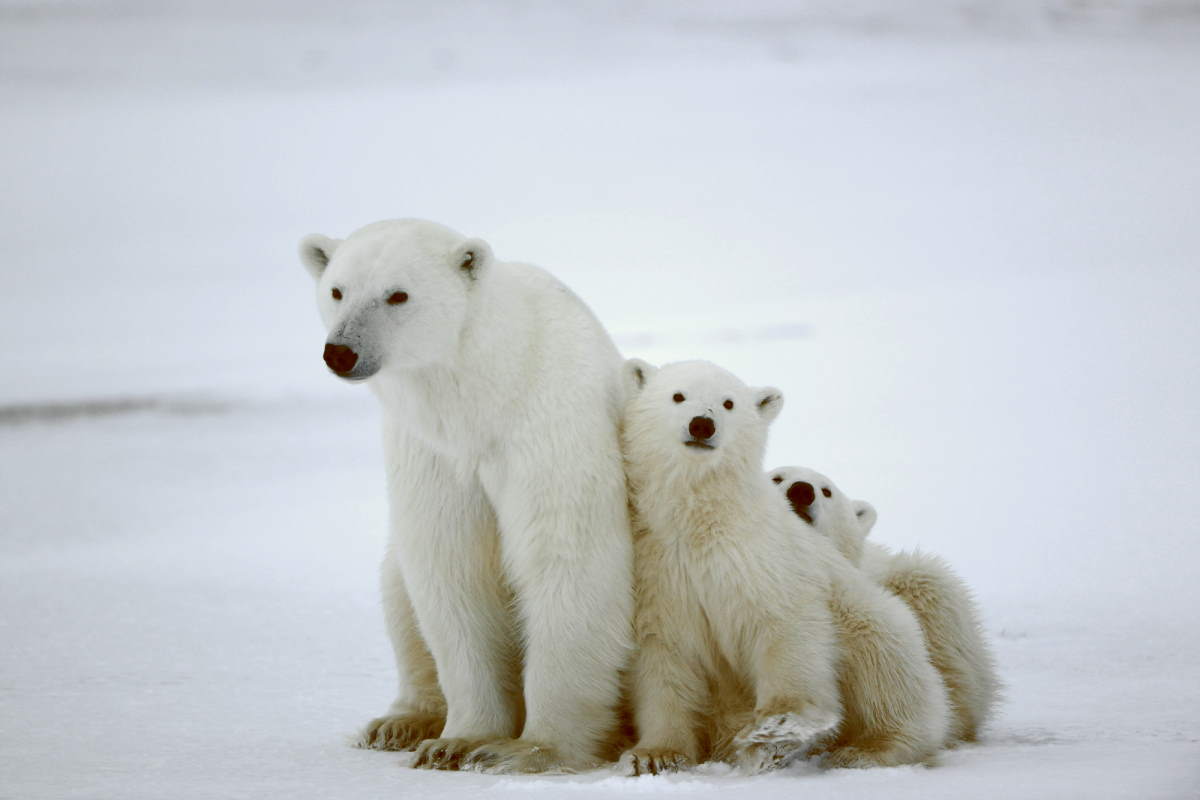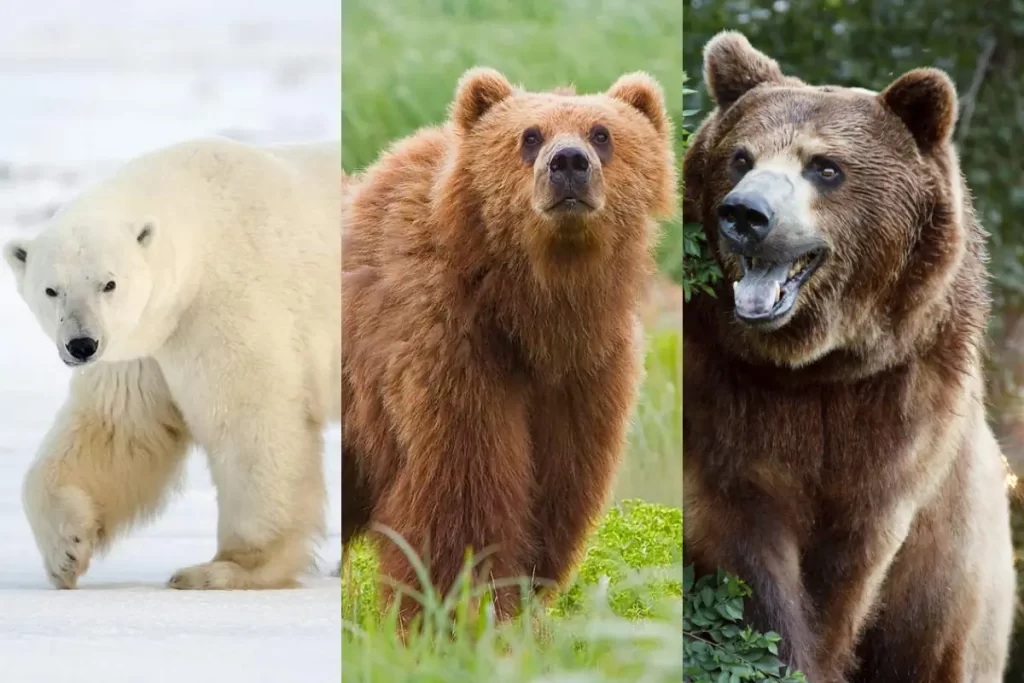Polar bears (scientific name: Ursus maritimus) are one of the most majestic and awe-inspiring animals on the planet. These massive predators are perfectly adapted to life in the harsh Arctic environment, with thick fur, webbed paws, and an incredible sense of smell that allows them to locate prey from great distances. In this article, we’ll take a closer look at polar bears, including some amazing facts about their size, behavior, and habitat. From the largest polar bear ever recorded to their incredible swimming ability, read on to discover 20 fascinating facts about these incredible animals.
Largest polar bear ever recorded
The largest polar bear on record reportedly weighing 1,002 kg (2,209 lb), was a male shot at Kotzebue Sound in northwestern Alaska in 1960. This specimen, when mounted, stood 3.39 meters (11 feet 1 inch) tall on its hind legs!
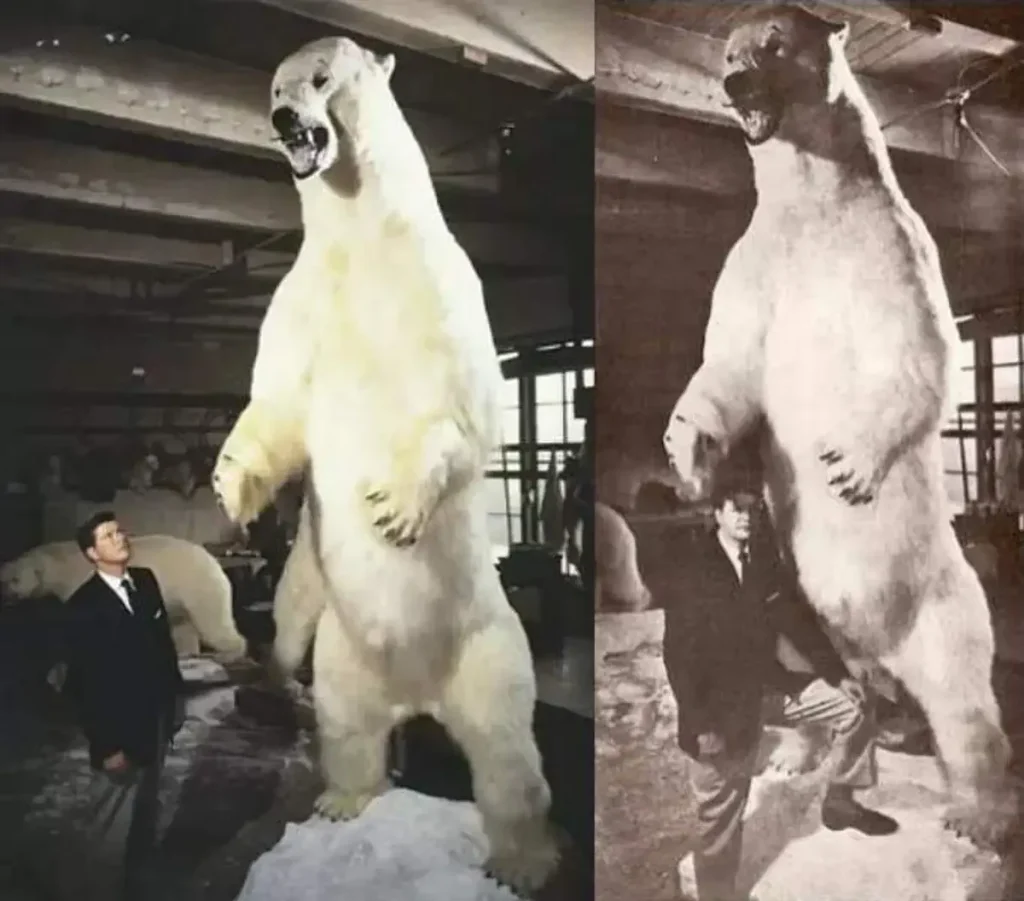
Polar bear facts
And here are 20 amazing facts about the polar bear.
1. The polar bear is the largest bear in the world
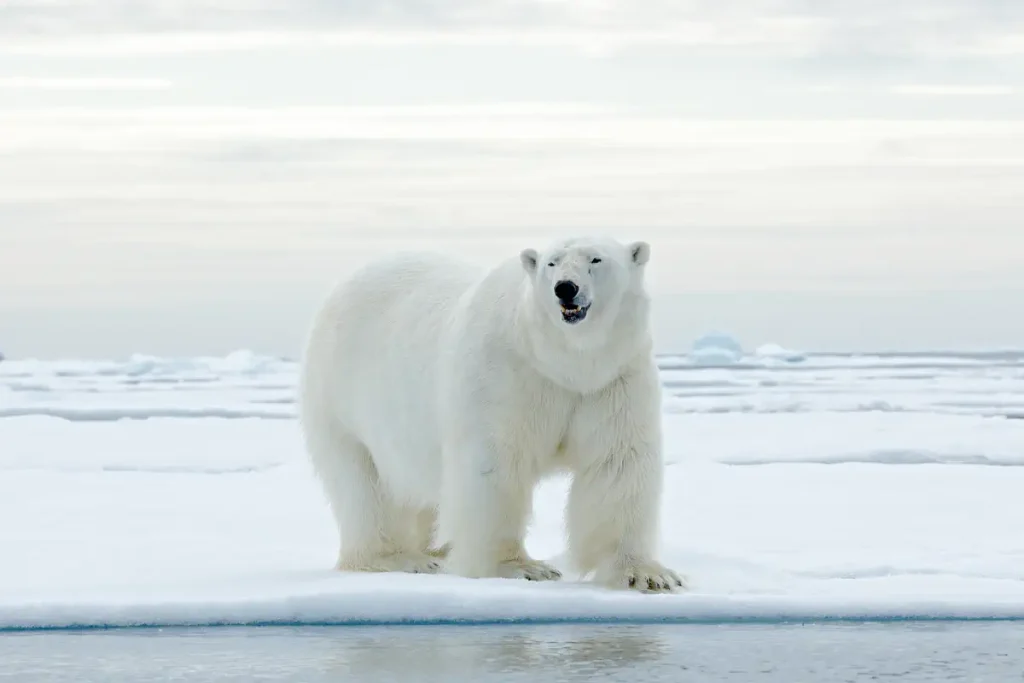
The polar bear is the largest bear on Earth. On average, A boar (adult male) weighs around 350-700 kg (772–1,543 lb), while a sow (adult female) is about half that size.
The largest brown bear, the Kodiak bear came a close second: males (boars) are 360 to 635 kg (794 to 1,400 lb) on average, while females (sows) from 225 to 315 kg (496 to 694 lb).
The typical shoulder height of an adult polar bear is 122 to 160 cm (4
An average adult Kodiak bear (male) measures 244 cm (8 feet) in length and stands 133 cm (4 feet 4 inches) tall at the shoulder. A large male Kodiak bear can stand up to 1.5 meters (4.9 feet) tall at the shoulder when it is standing on all four legs. When standing fully upright on its hind legs, a large male could reach a height of 3 meters (9.8 feet).
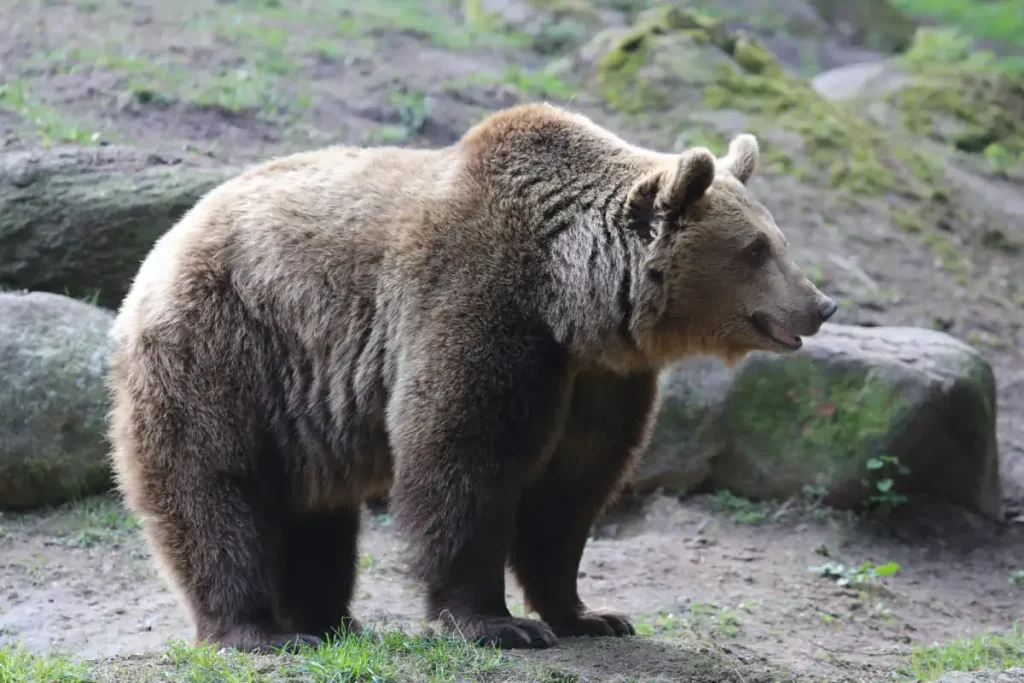
Related: Amazing Kodiak Bear Facts
2. The polar bear has the strongest bite force of all carnivore land mammals
The polar bear has the strongest bite force among all carnivore land mammals. It has an average canine bite force of 1646.7 Newton. For comparison, the lion’s average canine bite force is 1314.7 Newton, and a Kodiak bear’s average canine bite force is 1409.7 N.
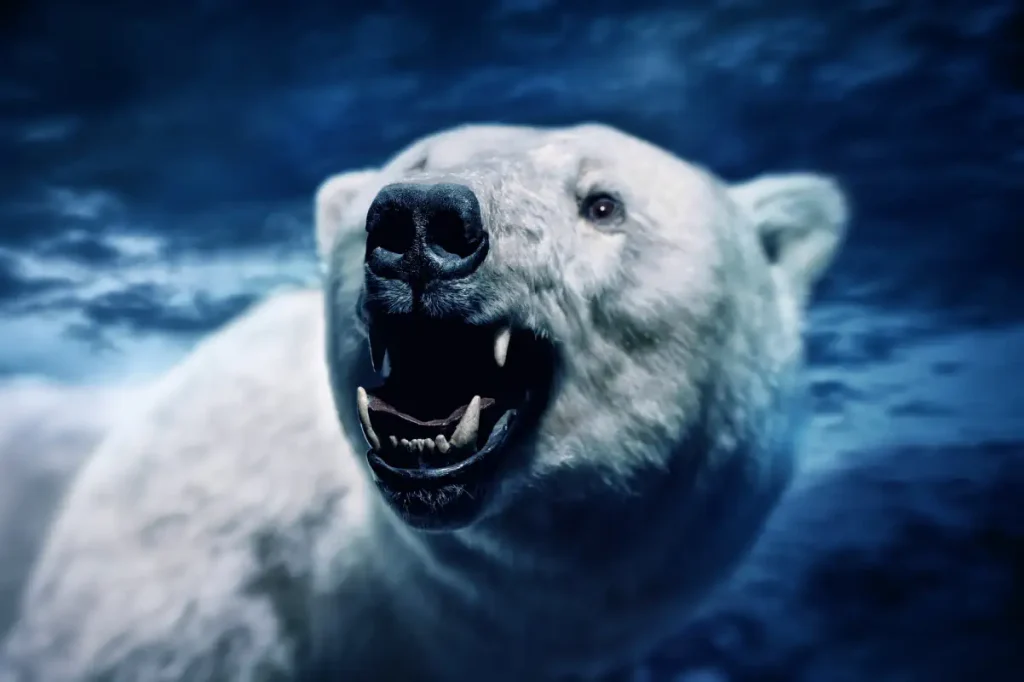
3. They are not territorial, but still very dangerous
Unlike grizzly bears, polar bears are not territorial, partly because their sea ice habitat is always moving and seasonally changing, expanding in winter and retreating in summer.
Although stereotyped as being voraciously aggressive, they are normally cautious in confrontations and often choose to escape rather than fight. Satiated polar bears rarely attack humans unless severely provoked.
However, due to their lack of prior human interaction, hungry polar bears are extremely unpredictable, fearless towards people, and are known to kill and sometimes eat humans.
Many attacks by brown bears are the result of surprising the animal, which is not the case with the polar bear. Polar bears are stealth hunters, and the victim is often unaware of the bear’s presence until the attack is underway. Whereas brown bears often maul a person and then leave, polar bear attacks are more likely to be predatory and are almost always fatal.
There’s a famous saying regarding the color of the bears: “If it’s black, fight back. If it’s brown, lay down. If it’s white, say goodnight.”
Luckily, due to the very small human population around the Arctic, such attacks are rare.
4. They live in the Arctic Circle, not in Antarctica
They are well adapted to survive in one of the harshest environments on our planet: the Arctic Circle. Their fur is thicker than any other bear’s and covers even their feet for warmth and traction on ice. A thick layer of blubber beneath their fur provides buoyancy and insulation.
There are no polar bears in Antarctica.
5. They are extremely good long-distance swimmers
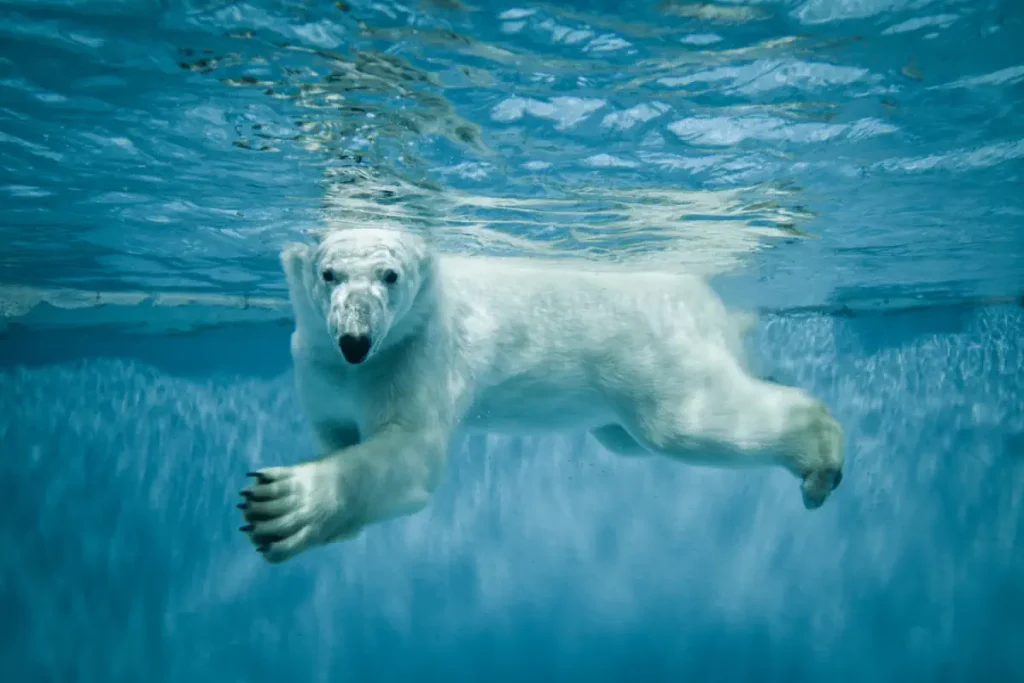
The polar bear is an excellent swimmer and can swim for days. Their long neck and narrow skulls probably aid in streamlining them in the water while warming the air that they breathe. Their front paws are large, flat, and oar-like, which also helps. They use them to paddle through the water while holding their hind legs flat like a rudder.
Once, r
They are not very fast swimmers, though, they comfortably swim at around 10 km/h (6 mph). Most of their prey can outswim them. For example, they simply aren’t quick enough to catch seals in open water. Instead, they depend on the ice as a hunting platform.
They sometimes swim underwater to catch fish.
6. Their skin is black
Polar bears have black skin to absorb heat from the sun, but their fur appears white to blend in with their environment. Yes, it “appears” white, which brings us to #6.
7. Their fur isn’t actually white
It is actually transparent with a hollow core that reflects light. This helps the bears blend in with their surroundings.
Their fur looks whitest when they are clean and in high-angle sunlight, especially just after the molt period, which usually begins in spring and is completed by late summer. Before molting, accumulated oils in their fur from the seals they eat can make them look yellow.
7. Their sense of smell is so good
A polar bear can smell its prey up to a kilometer away. They can even detect a seal in the water beneath a meter of compacted snow.
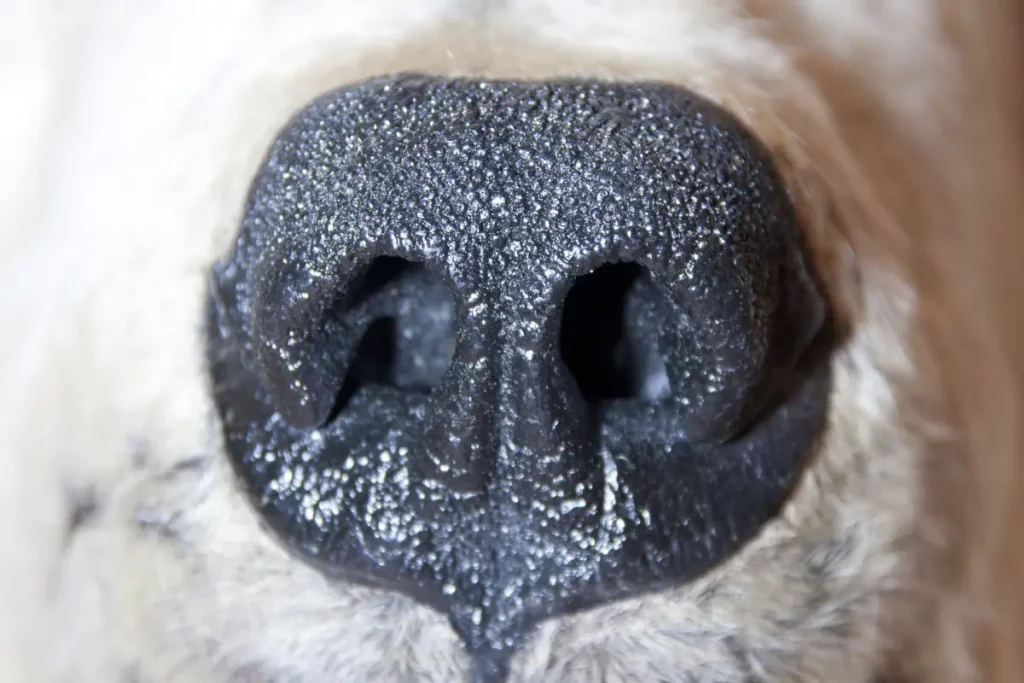
8. Polar bears do not hibernate
Unlike their brown and black counterparts, polar bears do not hibernate, with the exception of pregnant females. Unlike brown and black bears, they are capable of fasting for up to several months during late summer and early fall, when they cannot hunt for seals because the sea is unfrozen.
In fact, polar bears have a vestigial hibernation induction trigger in their blood, since they evolved from a common brown bear ancestor about 200,000 years ago. But it seems that that trigger does not work anymore.
9. Their diet is flexible
Polar bears are both hunters and scavengers. They mostly hunt seals and it is the primary and indispensable way of life for most polar bears. But they can consume a wide variety of other wild foods, including muskox (Ovibos moschatus), reindeer (Rangifer tarandus), fish, birds, eggs, rodents, crabs, other crustaceans, and… (ouch!) other polar bears.
They also occasionally eat plants, including berries, roots, and kelp; but, none of these have been a significant part of their diet.
They also scavenge on marine mammal carcasses (i.e. whales).
The polar bear’s metabolism is specialized to require large amounts of fat from marine mammals, and it cannot derive sufficient caloric intake from terrestrial food.
10. Grizzly-polar bear hybrids exist
In 2006, testing the DNA of a unique-looking bear that had been shot near Sachs Harbour, Northwest Territories on Banks Island in the Canadian Arctic confirmed that polar bears can breed with brown bears to produce fertile grizzly-polar bear hybrids – which are named the grolar bear, pizzly bear, or
Possible wild-bred polar bear-grizzly bear hybrids have been reported and shot in the past, but DNA tests were not available.
According to the WWF, hybrids are usually birthed from polar bear mothers and they are raised and behave like polar bears.
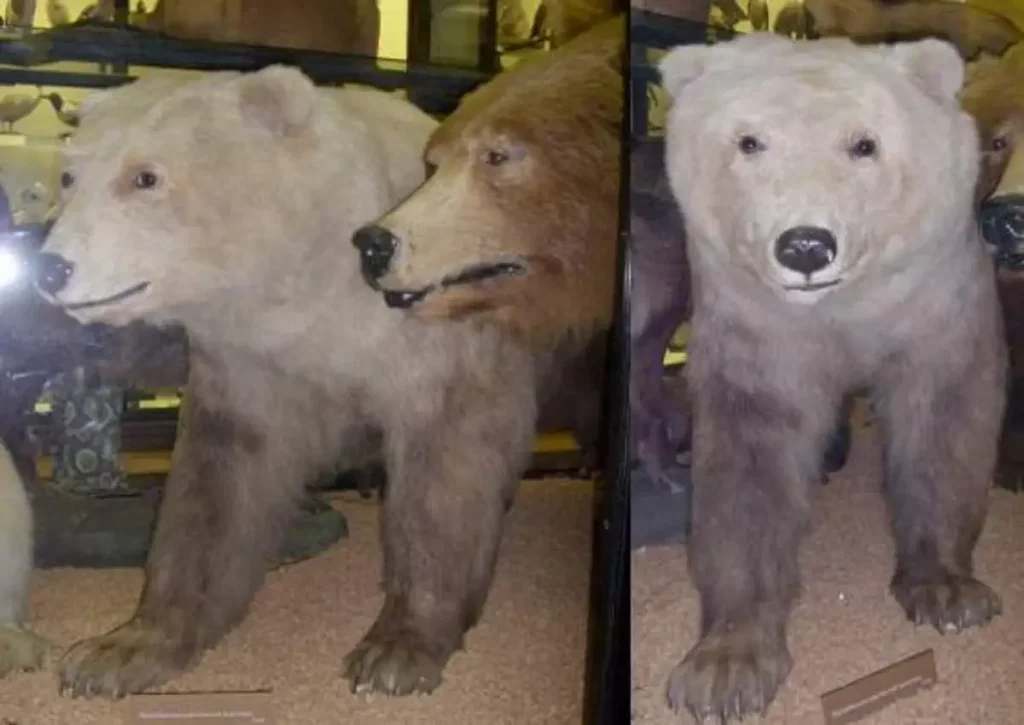
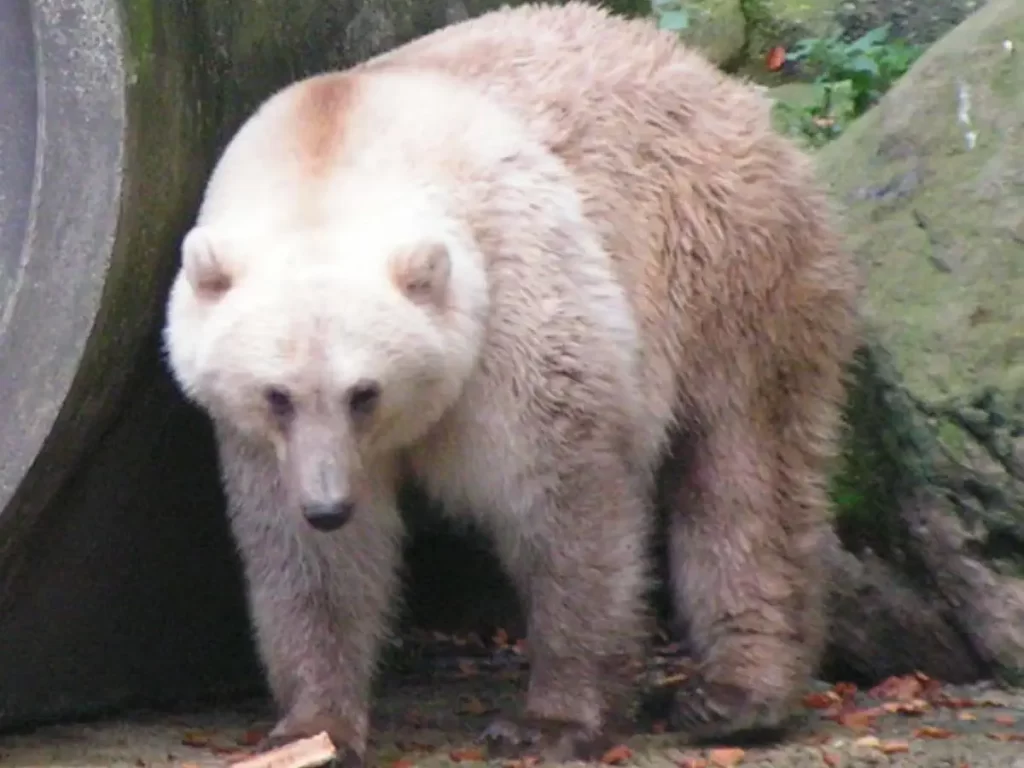
Related: 10 amazing Pizzly Bear facts
11. They have no natural enemies
Polar bears are apex predators, they are on top of the food chain. But, they may be vulnerable to predation by orcas (Orcinus orca – the killer whale) while swimming. There are no reported or documented cases of such predation or attempts to date, though.
But, in 2008, researchers found the jawbone of a young polar bear in the stomach of a Greenland shark.
12. They are solitary animals
Except for females with cubs, polar bears are solitary animals. Yet, they have often been seen playing together for hours at a time and even sleeping in an embrace, and polar bear zoologist Nikita Ovsianikov has described adult males as having “well-developed friendships”.
13. Cubs born blind and tiny
Polar bear cubs are born blind, covered with light-down fur, and weighing less than 0.9 kg (2.0 lb). On average, each litter has two cubs.
The cubs stay with their mother for about two years.
The mothers give birth between November and February, an adaption that ensures polar bear cubs will be born to healthy mothers at a time when their chances for survival are greatest.
But, in captivity, they might be delivered in the earlier months. The earliest recorded birth of polar bears in captivity was on October 11, 2011, in the Toronto Zoo.
The typical lifespan of polar bears in the wild is 18-20 years. The longest-living polar bear was a female named Debby, who died at the age of 41 or 42.
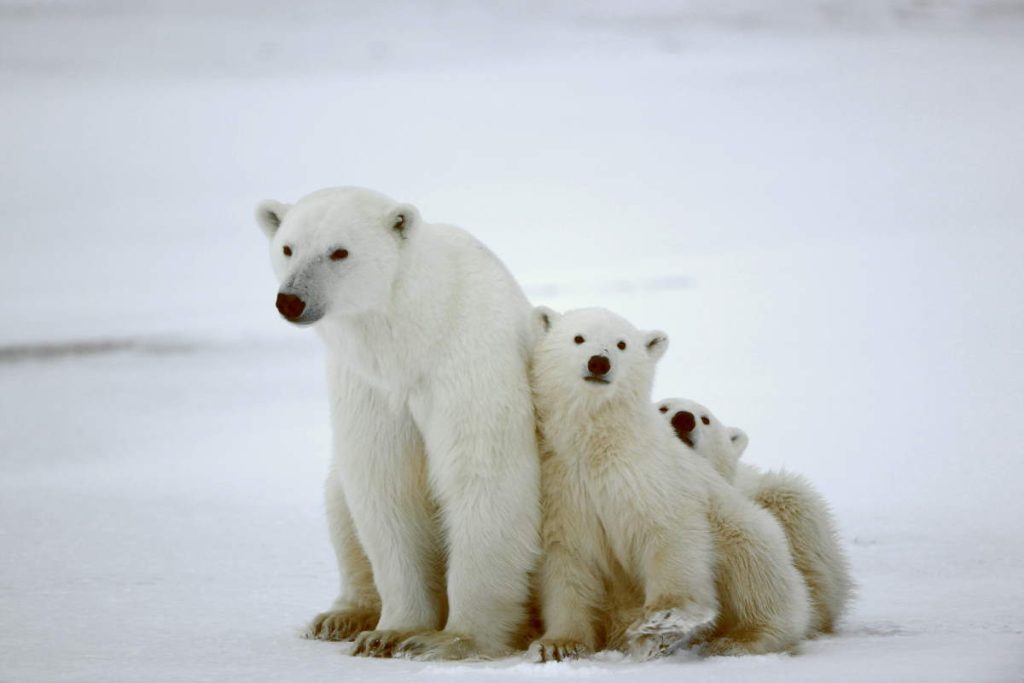
14. Mothers sometimes adopt orphaned cubs
Multiple cases of adoption of wild cubs have been confirmed by genetic testing.
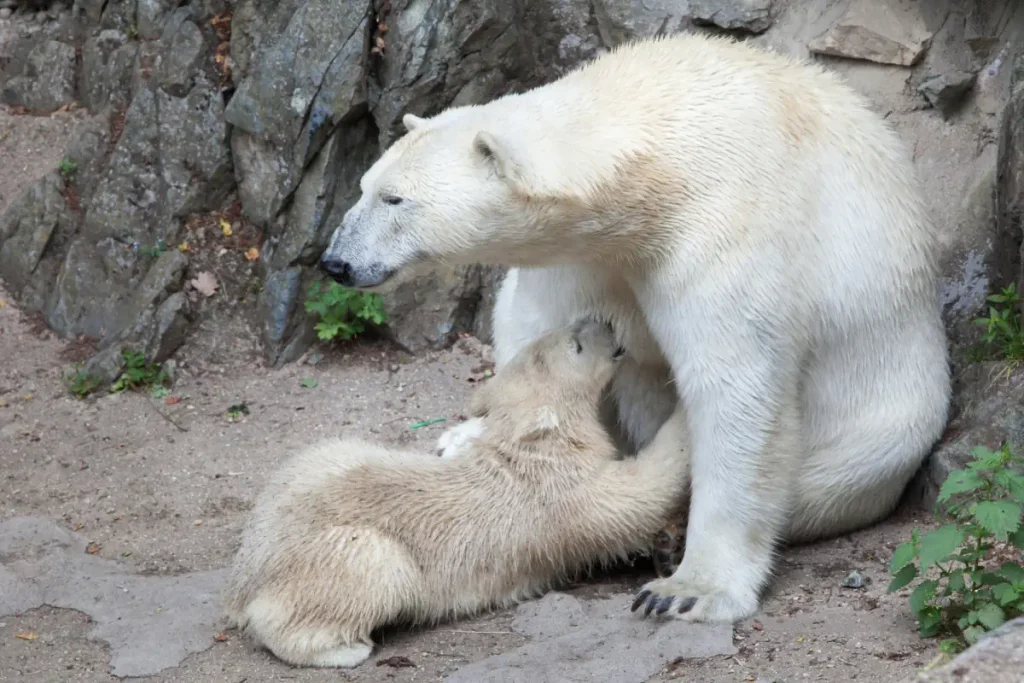
15. Less than 2% of their polar bear hunts are successful
Most terrestrial animals in the Arctic can outrun the polar bear on land as polar bears overheat quickly, and most marine animals the bear encounters can outswim it. As a result, only around 2% of their hunts are successful.
Like the brown bear, most ungulate prey of polar bears is likely to be young, sick, or injured specimens rather than healthy adults.
16. Their paws are really big
Their paws measure up to 30 centimeters (11.81 inches) across. This helps them tread on thin ice. They are also good for swimming, as big paddles.
Their claws are also thick, curved, sharp, and strong. Each measures more than five centimeters (1.97 inches) long. Polar bears use their claws to catch and hold prey and to gain traction on ice.
17. They rest a lot
Like all the big predators, Polar bears rest a lot, up to 20 hours a day when they’re not hunting or traveling long distances.
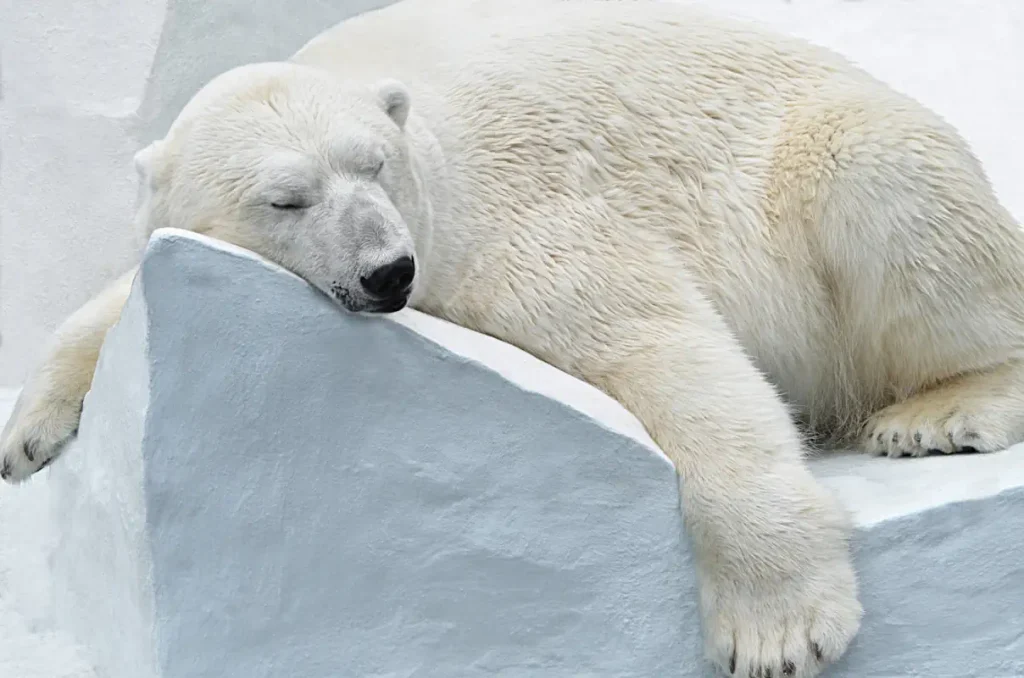
18. They are amazing long-distance travelers
Polar bears are not fast animals, both in the water and on the land. They walk approx. 5-6 kilometers per hour, and swim at 10 km/h. But, they can cover very long distances.
One satellite-tracked female traveled 4,796 kilometers (2,980 miles) from Alaska’s Prudhoe Bay to Greenland to Canada’s Ellesmere Island and back to Greenland. During the journey, she lost 22% of her body mass and her yearling cub died.
Also, when a young polar bear grows up, it may travel more than 1,000 kilometers to set up a home range apart from its mother’s.
19. Polar bears mostly live in Canada
As of 2018, the total number of polar bears is estimated at 26,000. Around 60% of them live in Canada.
There are as many as 19 subpopulations of the polar bear. According to the WWF, of these just 1 subpopulation is increasing, 5 are stable and 4 are in decline. The remaining 9 have not been assessed as they are data deficient.
20. They have a lot of names
In the Norse poets (medieval Scandinavia), polar bears were referred to as the white sea deer, the seal’s dread, the rider of icebergs, the whale’s bane, and the sailor of the floe. They were also praised for having the strength of 12 men and the wit of 11.
The Sami people (indigenous people from northern Europe) call them the god’s dog or the old man in the fur cloak. They also refuse to say “polar bear” for fear of offending them.
In the Inuit language, their names are Nanuk (an animal worthy of great respect) or Pihoqahiak (the ever-wandering one).
The Kets (a Siberian tribe) calls them Gyp or Orqoi, meaning grandfather or stepfather, as a sign of respect and awe.
In the Russian language, their name is Beliy Medved (the white bear). In Norway and Denmark, they are known as “Isbjorn”, the “ice bear”. In Eastern Greenland, people call them “Tornassuk”, which means “the master of helping spirits”.
Their scientific name is “Ursus maritimus”, which means “sea bear”.
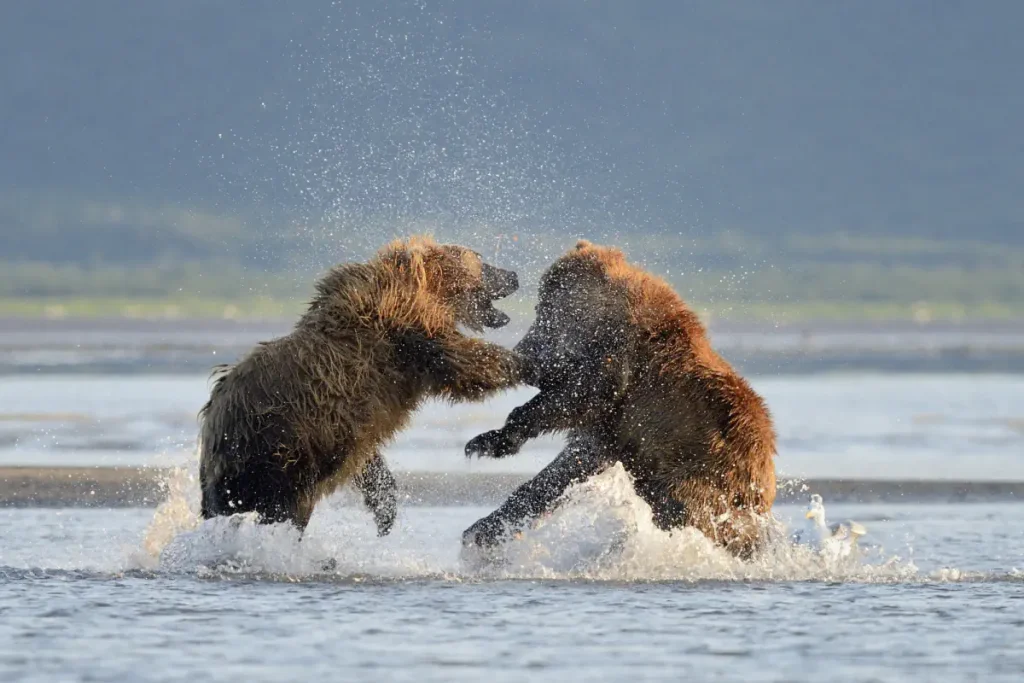
Related: 20 amazing Grizzly Bear facts
Some not-amazing polar bear facts
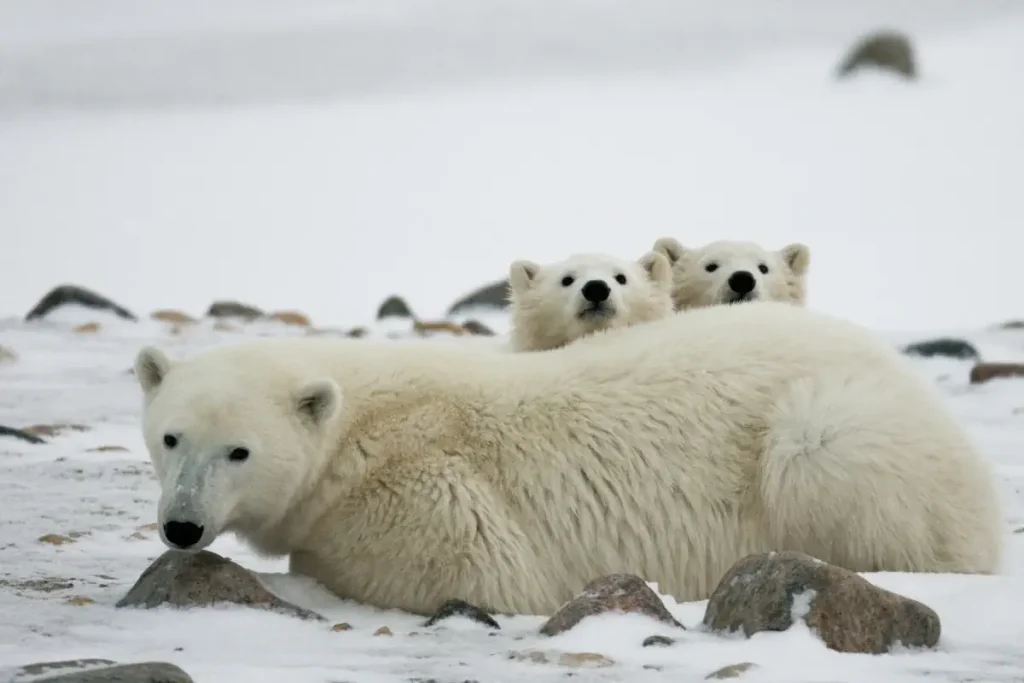
Polar bears were one of the first species to become threatened due to anthropogenic climate change. They rely on sea ice to cover large areas in search of food. A longer melting season due to climate change means that sea ice is forming later and breaking up earlier in the year, restricting the polar bears’ feeding range. This is particularly impactful on pregnant females, who need to build up fat stores to live off of when birthing and nursing cubs.
Other risks include pollution in the form of toxic contaminants, conflicts with shipping, oil and gas exploration and development, hunting, and human-bear interactions including harvesting and possible stresses from recreational polar bear watching.
Organizations such as WWF are working hard to secure a future for polar bears. You can help them by adopting a polar bear and supporting their crucial on-the-ground research and conservation projects. You can also check out the polar bear tracker to see the polar bears they are monitoring and what they learn from them.
Notes
- If an animal has a diet that is more than 70% meat then it’s called a hypercarnivore. All felids, including your house cat, are hypercarnivorous, for example. Some examples include crocodiles, alligators, owls, shrikes, eagles, felids, dolphins, orcas, snakes, spiders, scorpions, mantises, marlins, groupers, and most sharks. Most wild canids (wolves, foxes, etc) and domesticated dogs are not hypercarnivorous).
Sources
- Polar bear on Wikipedia
- Hypercarnivore on Wikipedia
- Kodiak bear on Wikipedia
- “10 facts about polar bears” on National Geographic kids
- “Basic facts about polar bears” on defenders.org
- “11 facts you didn’t know about polar bears” on the World Wildlife Fund webpage
- Grizzly-polar bear hybrid on Wikipedia
- “21 Cool Polar Bear Facts” on San Diego Zoo webpage
- Polar Bears International webpage
- How Many Elephants are Left in the World in 2025? - August 17, 2025
- Moon Landings: All-Time List [1966-2025] - February 2, 2025
- What Is Max-Q and Why Is It Important During Rocket Launches? - January 16, 2025
